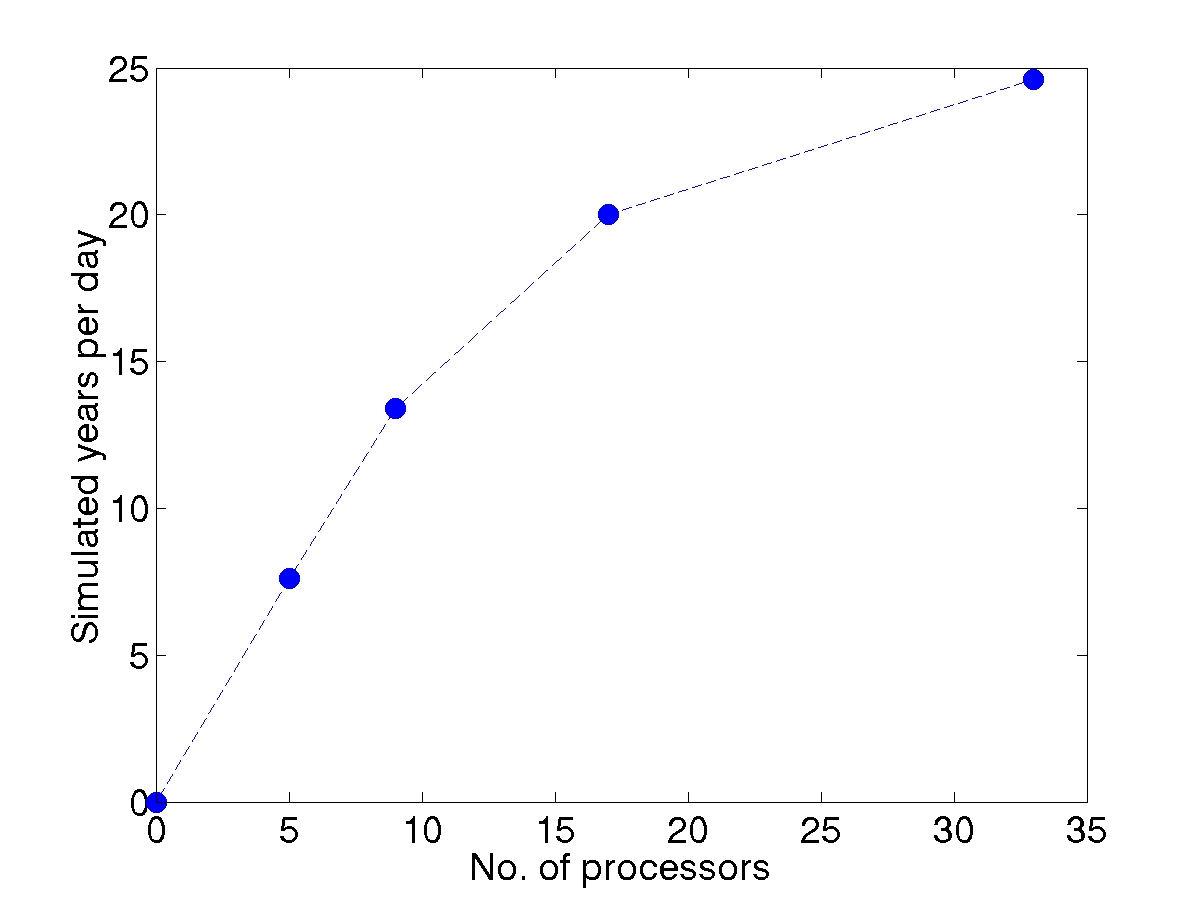MITgcm Coupled 2.8 degree Atmosphere Ocean and Seaice Configuration - JMC Code L Baseline
These pages describe an intermediate complexity coupled configuration of
MITgcm.
- A description of the current configuration can be found below.
- The code for this configuration can be downloaded from here.
- A users guide for the coupled configuration can be found here and downloaded
from here.
- Output fields from the simulation can be found in the results section below.
- Time to solution summary can be found in the time to solution section below.
- Results of scaling tests can be found in the configuration scaling section below.
- Plans for future development are described in the future development plans section below.
The configuration described here is the ESMF
JMC Code L Baseline configuration. This is a coupled atmosphere ocean simulation
that uses MITgcm for both fluids. The isomorphic equation set that is used
in both fluids is described in the Continuous Formulation section
of the first chapter of the MITgcm release1
documentation.
Additionally a thermodynamic ice model is included for
sea-ice covered regions. Land surface processes are driven by climatologies
of soil moisture, land temperature and albedo.
The fluid equations are stepped forward on a latitude longitude grid using
the time stepping procedure outlined in the Time Stepping
section of the second chapter of the MITgcm release1
documentation.
The sections Spatial discretization of the dynamical eqautions
and Tracer equations describe the form of the
horizontal (latitude-longitude) and vertical (pressure in the
atmosphere and height in the ocean) spatial gridding.
Computationally the system is configured as three separate
executable programs that are derived from the MITgcm
code base. Additional MITgcm packages are included in the
coupled configuration to support sea-ice and surface boundary flux
calculations and to support data transport between programs.
The code structure for each program follows the outline give under the
Browse Code tab of the MITgcm release1
web page.
The approach to parallelism is described in the
Software Architecture chapter of the MITgcm release1
documentation.
The directory structure for the contents of the downloaded
source tree are described in a README file in that
source tree. The layout and build procedures follow closely the
arrangement described in the MITgcm documentation, however,
for this configuration the code organization contains
independent MITgcm code trees for each of the three separate
executable components. The standard MITgcm genmake
tool is used, but it is driven from a
higher level build script described in the
confiugration users guide.
The downloaded configuration is set to simulate a ten-day period following a
fifty year spin up. The figure below shows the monthly average of the ocean currents
for the upper ocean (25m and 170m deep) at the start of the August immediatly prior to
the fifty year pickup.

Velocity vectors for the top and third ocean levels (25m and 170m) after
49 years and 8 months of integration
Atmospheric winds for the same period at 950mb and 500mb are shown below.

Wind vectors from the lower and mid atmospheric levels (950mb and 500mb) after
49 years and 8 months of integration
The time to solution for a 17 processor run is measured as 120 seconds on the
HP Alpha system at NASA Goddard ( halem.gsfc.nasa.gov ). This is the time
for a ten-day simulation that starts from a spun-up fifty year state.
The base time-step for this configuration is 450 seconds.
In a ten day period all the elements of the coupled system are excercised
many times so that the timing is representative of extended simulations.
The time to solution has also been measured at other processor sizes
in order to allow a scaling profile to be calculated.
The latitude longitude configuration scaling has been tested to 33 processors
on the HP Alpha at NASA Goddard (halem.gsfc.nasa.gov).
The plot below shows the number of simulated years per day that the system
currently achieves for different processor counts.
Scaling of latitude-longitude grid point scheme with processor count.

Throughput in years of coupled simulation per day for 2.8 degree
couple configuration JMC Code L Baseline.
During the course of the ESMF project the coupled code that forms the basis for JMC Code L will evolve
in all of the following areas
- A framework compliant form will be developed
- A coupled scheme based on the cubed-sphere grid will be developed.
- Higher end atmospheric physics will be deployed.
- Higher end ocean eddy and boundary layer paramerizations will be deployed.
- A fully dynamic ice component will be deployed.
- A simplified interactive land surface component will be deployed.
- An flexible ensemble driver will be overlaid on the configuration.
- Additional options for automatic differentiation will be introduced.
These developments will affect both the scaling and the time to solution for the
test problem in both its non-framework compliant and framework compliant forms.
Authors: Stephanie Dutkiewicz, Jean-Michel Campin, Chris Hill.
Department of Earth, Atmospheric and Planetary Sciences, MIT



